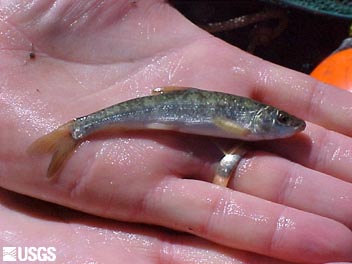- Home
- About S&T
- Taxa/Organisms
- Ecosystems
- Issues
- Methods & Tools
- Reports & Publications
- Location
- Search
2008 | Publisher: Other (RSC Publishing, Journal of Environmental Monitoring) | Format: URL
www.rsc.org — Environmental contaminant and biomarker monitoring data from major U.S. river basins were summarized for black bass (Micropterus spp.) and common carp (Cyprinus carpio) sampled over a nine year period. Cumulative frequency distributions revealed taxon differences for many organochlorine residue concentrations, elemental contaminant concentrations, More...

May 4 2007 | Publisher: Other (Springer New York) | Format: URL
www.springerlink.com — This project is an evaluation of three potentially nonlethal alternatives to fillet sampling for the determination of mercury (Hg) concentrations in smallmouth bass (Micropterus dolomieu) to monitor mercury concentrations in smallmouth bass (micropterus dolomieu) from six sites in southern Missouri were captured by electrofishing. Blood samples More...

2002 | Publisher: USGS | Science Center: Western Fisheries Research Center (WFRC, Seattle) | Format: URL
wfrc.usgs.gov — The value of this long-term monitoring program will provide data crucial for understanding demographic and reproductive characteristics of these endangered sucker populations. This research will have wide applicability to federal, state, and tribal agencies in the basin for management and recovery efforts.

2002 | Publisher: USGS | Science Center: Great Lakes Science Center (GLSC, Ann Arbor) | Format: .PDF
www.glsc.usgs.gov — In 2002, scientists from the Great Lakes Science Center assessed the health of the populations of preyfish for the biennial State of the Lakes Ecosystem Conference (SOLEC) to provide information to policy makers on the status of the lakes and future needs. Preyfish population is one of the 80 indicators used by SOLEC to determine the health of the More...

Publisher: USGS | Science Center: Western Fisheries Research Center (WFRC, Seattle) | Format: URL
wfrc.usgs.gov — An entrainment study at Grand Coulee Dam indicated that 200,000 - 600,000 kokanee were entrained, primarily at the 3rd powerhouse, during a 40-month time period. Following the recommendations of the Independent Scientific Review Panel, research was initiated to investigate a strategy to reduce entrainment by using strobe lights to repel salmonids More...

Publisher: USGS | Science Center: Western Fisheries Research Center (WFRC, Seattle) | Format: URL
wfrc.usgs.gov — This research summary reports on the decline of Pacific lampreys (Lampetra tridentata) in the Columbia River Basin. Their numbers have declined to only a remnant of their pre-1940's populations. One factor that could be detrimental to lamprey production is the amount of energy they expend negotiating upstream fish passage facilities at dams. An More...

Publisher: USGS | Science Center: Western Fisheries Research Center (WFRC, Seattle) | Format: URL
wfrc.usgs.gov — The goal of this study is to determine egress routes and egress timing of juvenile salmon with respect to passive particle movement in the tailrace of John Day Dam using ultra-sonic fish tracking technology. The objectives are to evaluate egress routes and egress timing of juvenile spring chinook salmon with respect to paired releases of neutrally More...

Publisher: USGS | Science Center: Western Fisheries Research Center (WFRC, Seattle) | Format: URL
wfrc.usgs.gov — This is a research summary who's project objectives are to: 1) Coordinate watershed stakeholders in order to guide the implementation of watershed restoration actions that are consistent with stakeholder objectives, 2) Monitor physical habitat conditions and natural production of juvenile, smolt, and adult steelhead in the Wind River sub-basin, More...

Publisher: USGS | Science Center: Western Fisheries Research Center (WFRC, Seattle) | Format: URL
wfrc.usgs.gov — Mercury contamination from historic gold mining operations is widespread in many rivers, lakes, and reservoirs on the western slopes of the Sierra Nevada. A multidisciplinary investigation by USGS is attempting to better understand mercury dynamics and to identify hot spots within Camp Far West Reservoir in order to determine if remediation More...

Publisher: Other (ScienceDirect (Elsevier)) | Format: URL
tinyurl.com — Organochlorine pesticide and total polychlorinated biphenyl (PCB) concentrations were measured in largemouth bass from the Tombigbee River near a former DDT manufacturing facility at McIntosh, Alabama. Concentrations of DDT isomers in McIntosh bass remained unchanged from 1974 to 2004 and were four times greater than contemporary concentrations More...

Publisher: USGS | Science Center: Upper Midwest Environmental Sciences Center (UMESC, LaCrosse) | Format: URL
www.umesc.usgs.gov — Paddlefish (Polyodon spathula) have been lost from four states and Canada, and 11 of 22 states within the remaining species range now list the paddlefish as endangered, threatened, or a species of special concern. Restoration of paddlefish populations is a shared goal of many state and federal agencies. UMESC scientists, in collaboration with the More...

Publisher: USGS | Science Center: Western Fisheries Research Center (WFRC, Seattle) | Format: URL
wfrc.usgs.gov — The objectives of this study are 1) to determine how and when juvenile suckers use near-shore habitat with emergent vegetation, 2) determine how the distribution and abundance of juvenile suckers varies between near shore and offshore areas as well as between different areas of the lake over time, 3) determine if water quality conditions affect More...
